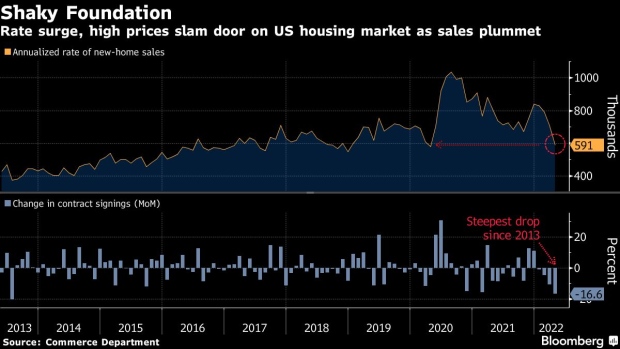May 28, 2022
US Economic Data Signals Firmer Growth That May Ease by Yearend
, Bloomberg News

(Bloomberg) -- Firmer consumer spending and a decisive narrowing of the merchandise trade deficit show the US economy is emerging in short order from a first-quarter pothole.
Sustaining that momentum later this year is more of a question mark as manufacturing and housing soften along with employment and wage growth. Inflation, while easing a bit, remains elevated and the Federal Reserve will continue to press harder on the monetary policy brakes.
In April, inflation-adjusted household purchases posted the strongest advance in three months and will help queue up a rebound in gross domestic product this quarter. The goods-trade deficit -- a huge contributor to the 1.5% annualized decline in first-quarter GDP -- shrank last month by the most since 2009.
While these developments are reasons for optimism about the economy, regional manufacturing surveys showed setbacks, while orders for capital equipment moderated a touch.
Next week, the government is projected to report that employment growth cooled in May, suggesting labor demand is starting to become less heated. That may help to alleviate wage pressures later this year and eventually provide some comfort to central bankers as they seek to reduce inflation.
Consumer Resilience
Consumer spending was strong in April, rising 0.7% on an inflation-adjusted basis. But the saving rate fell to the lowest level since 2008, indicating that Americans are increasingly relying on savings as price pressures strain budgets.
The spending increase was broad-based, driven by both goods and services. Economists have been expecting demand for services like travel and entertainment to outpace outlays for merchandise as pandemic concerns subside, but inflation-adjusted spending on goods rose 1% in April from the prior month and services increased 0.5%.
The “report makes clear that consumers continue to consume despite facing the highest inflation in 40 years,” Wells Fargo & Co. economists Tim Quinlan and Shannon Seery wrote in a note. “But, we’re getting closer to the end of the lollipop,” they said, noting the decline in the saving rate.
At the same time, while year-over-year inflation is cooling, it is still running three times faster than the Fed’s 2% target and helps explain why central bankers are expected to implement half-point interest rate hikes in coming meetings. That could also lead to a downshift in consumer spending over the next several quarters, the Wells Fargo economists wrote.
Housing Stumbles
The hot housing market of last year is cooling rapidly, as a steep climb in mortgage rates compounds affordability issues.
In April, sales of new homes plummeted the most in nearly nine years, according to government data Tuesday. A gauge of contract signings on previously owned houses fell for a sixth straight month, the longest such skid since 2018.
The data show that the Fed’s interest rate hikes and telegraphing of more increases are broadly curbing demand. Mortgage rates, which have fallen in the last two weeks, are still hovering near the highest since 2009, according to Freddie Mac.
In another sign that the pace of the market is decelerating, the number of home sellers lowering asking prices reached the highest level since October 2019. Other measures of how hot the market is, including a house’s time on market and the percentage of homes selling above listing price, have also plateaued, Redfin Corp. data showed.
Manufacturing Moderating
Government figures this week showed a 0.8% gain in shipments of core capital goods that may allow for firmer business outlays for equipment at the start of the second quarter. At the same time, growth in core orders moderated after a March surge.
The figures suggest companies are adhering to capital expenditures plans as they seek to enhance productivity to ease the burden of high inflation and a tight labor market. It’s less clear, however, whether businesses later this year will reconsider the current pace of investment in the face of higher interest rates and an anticipated cooling of economic growth.
The most-recent regional Fed bank surveys showed a clear pullback in activity. Manufacturing gauges in New York state and the Richmond and Philadelphia Fed regions all declined in May and are at or near their lowest levels since mid-2020.
Softer production growth, in conjunction with a pickup in inventories, may help further limit demand for goods and materials made overseas. The government reported Friday that the merchandise-trade deficit shrank nearly by nearly $20 billion in April.
Imports fell 5% during the month on less demand for industrial supplies, capital goods and consumer merchandise.
©2022 Bloomberg L.P.






